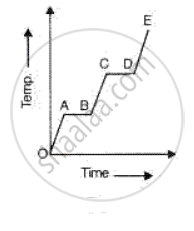Advertisements
Advertisements
प्रश्न
Two metals A and B have specific heat capacities in the ratio 2:3. If they are supplied same amount of heat then
Which metal piece will have greater mass if the rise in temperature is the same for both metals?
उत्तर
In this case, rise in temperature is same (Δ t) and masses are different.
So, for metal A,
Amount of heat (Q) = mA × 2 C × Δt;
and for metal B,
Amount of heat (Q) = mB × 3 C × Δt.
Now we can write, mA × 2C × Δt = mB × 3C × Δt.
Simplifying, mA = 1.5 mB.
Therefore, it can be said that metal A will have a greater mass than metal B.
APPEARS IN
संबंधित प्रश्न
Define heat capacity and state its SI unit.
A mass m1 of a substance of specific heat capacity c1 at temperature t1 is mixed with a mass m2 of other substance of specific heat capacity c2 at a lower temperature t2. Deduce the expression for the temperature t of the mixture. State the assumption made, if any.
A substance is heated at a constant rate from a low temperature to a high temperature. A graph of temperature against time is shown in the figure. Which part or parts of the graph correspond(s) to the substance existing in two states?

Specific heat capacity of a substance A is 3.8 J g-1 K-1 and of substance B is 0.4 J g-1 k-1. Which substance is a good conductor of heat? How did you arrive at your conclusion?
Water boils at 120 °C in a pressure cooker. Explain the reason
What is heat? What is the S. I. unit of heat?
A certain amount of heat Q will warm 1 g of material X by 3°C and 1 g of material Y by 4°C. Which material has a higher specific heat capacity?
How much heat energy is necessary to raise the temperature of 5 kg of water from 20°C to 100°C?
Conductors have generally high specific heat capacities and insulators have low specific heat capacities.
The molar specific heats of an ideal gas at constant pressure and volume are denoted by Cp and Cv, respectively. If `gamma = "C"_"p"/"C"_"v"` and R is the universal gas constant, then Cv is equal to ______.
